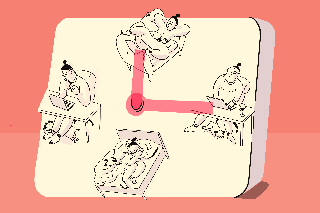Napper's Delight: How Coronavirus Normalized the Afternoon Snooze for America's Burnt-Out Workforce

Every afternoon, Justin David Carl takes a 30-minute break from his day.
Not to eat his desk-side salad, or to make a fresh pot of coffee. Instead, the tech sales executive begins with a 10-minute meditation and dozes off into a 20-minute nap. Coworkers know not to interrupt.
“I have it blocked off on my calendar,” he says.
Carl, who works at Garten, a Burlingame, Calif.-based office snacks company, says he occasionally got an afternoon nap in during the pre-coronavirus workday. But now that he works from home, it’s easier than ever. After all, you can literally “just crawl into bed,” he says.
As white collar Americans continue to work remotely in the wake of the pandemic, they’re putting the afternoon nap in the spotlight. Many employees enjoy fewer disruptions and more privacy in their home offices, and even those who don’t (sorry parents) now have the opportunity to schedule more downtime into their days.
“It's become more normalized to step away,” says Ryan Burch, founder of the Tobie Goup, an ad agency in Tempe, Ariz., who says he’s been taking naps several times a week since his office went remote this spring. “It’s easier for people to take a mental break and not feel as guilty.”
Regular napping still carries a stigma in some employment environments. Only 4% of businesses have an onsite nap room, and only 21% have a quiet space that employees can use to relax, according to 2019 data from the Society for Human Resource Management. So understandably, not everyone is comfortable revealing why they suddenly stopped replying to Slack messages or emails — even at home.
“I don’t broadcast it openly,” says Staci Wallace, who works for the telecommunications firm VoxOx out of her Frisco, Texas home.
Wallace makes it a point to plan a 15 to 20 minute nap during her busiest days to combat stress. These breaks are a must, she says, “when I’m running intense conversations, strategy sessions and other things that require a lot of left brain work.” She likes having the convenience of being able to fall asleep quickly in her own bed — and the fact that she can ask her husband, who also works from home, to wake her up.
Napping during the day makes it easier for some people to follow their natural circadian rhythm, which hits a low point in the afternoon, says Lawrence Epstein, medical director of Clinical Sleep Medicine at Brigham and Women's Hospital in Boston. Sleeping for short periods of time when the body feels naturally tired also helps people feel more alert when they’re awake. Some of Epstein’s own patients “are reporting that they’re doing much better because they are on their own schedule,” he says.
This isn’t true for everyone: Some people report getting poorer sleep due to shelter-in-place orders, Epstein says. But even in these cases, napping can be useful, since it allows those struggling to sleep due to pandemic-related stress to catch up when they can.
Still, many bosses shy away from straight up telling employees that it's ok to sleep on the job, says Shaon Hines, president of the Illinois Association of Naturopathic Physicians.
“Companies may not be educated on all the research that’s been done on napping,” she says. “Napping isn’t as trendy as meditation right now, but they really have a lot of the same benefits.”
Hines, for her part, prefers taking a nap before 3 p.m. so it doesn’t impact her ability to fall asleep in the evening. She often naps in her cool, dark basement.
“Now that I’m home, I'm able to do it more effectively,” she says.
Pros tips for getting some WFH shuteye:
Try the “nappaccino"
Some nappers, including author Daniel Pink, advocate for drinking coffee right before taking a nap. Since caffeine takes about 25 minutes to really wake you up, the caffeinated beverage will start to work as you get up from your nap.
Create a routine
Disable phone alerts, set an alarm and choose a dark, cool space to rest. (Many people have an easier time falling asleep in their own bed — even during the day, according to Hines.)
Find your afternoon slump
While we’re naturally sleepy during the night, our body’s circadian rhythm hits another low point in the middle of the day, which is why we experience some tiredness during the day, says Epstein.
Keep it short
Naps that are 30 minutes or less are actually more rejuvenating. During a longer nap, “you’re more likely to fall into deeper sleep and experience sleep inertia,” a feeling that makes it harder to wake up fully, Epstein says.
More from Money:
Working From Home Isn’t as Cheap as You Think It Is
‘Social Media Manager’ is One of the Most Popular Jobs in the US. It’s a Lot Harder than it Sounds
Yes, the World is on Fire. Here’s Why I Started Saving for Retirement Anyway